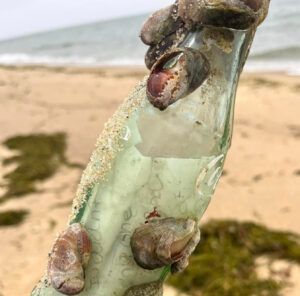 HYANNIS – Everyone’s familiar with the scenario of someone choking on a piece of steak until a good Samaritan swiftly gives the victim a Heimlich maneuver and out pops the chunk of food. Crisis averted.
HYANNIS – Everyone’s familiar with the scenario of someone choking on a piece of steak until a good Samaritan swiftly gives the victim a Heimlich maneuver and out pops the chunk of food. Crisis averted.
But what about when the chunk of food is not stuck in the airway, but in the esophagus, the tube leading from the mouth to the stomach? The victim can breathe, but may have chest pain, difficulty swallowing, and be coughing, gagging and drooling.
“In this case, they may get anxiety and panic,” said Jay Yamin, MD, a gastroenterologist with the GI Clinic in Hyannis.
The problem, called food impaction, can lead, in rare instances, to breakdown of the esophageal tissue – causing a hole or perforation in the esophagus – if not treated promptly. Cape Cod Hospital has dealt with about 100 cases so far this year, according to Dr. Yamin.
Food impactions are a common problem on the Cape, he said.
“Seems to happen a lot down here. I think it has to do with the age of the population and the influx of young people in the summer.”
Treatment may start in the emergency room with an injection of glucagon to relax the sphincter at the bottom of the esophagus so the bolus of food can pass into the stomach. A carbonated beverage may also be tried. The carbon dioxide gas creates pressure in the esophagus above the food, and may push it down, Dr. Yamin said. If this is not effective endoscopic removal is necessary.
Glucagon may also be given immediately prior to endoscopy – the insertion down the esophagus of a device that allows a doctor to see the problem, take tissue samples and either push the food down or remove it. Dr. Yamin said unless he can see past the obstruction, he prefers to remove the food rather than push it down, as pushing could injure the surrounding tissue. Suction, forceps, baskets and other tools can be introduced through the endoscope to remove the stuck material.
Underlying Issues
Food impactions usually involve an underlying issue. One of the most common is a narrowing or stenosis of the esophagus. This can take the form of a ring of tissue or a stricture, often caused by irritation from chronic acid reflux. According to a paper by Dr. Hin Hin Ko in the Canadian Journal of Gastroenterology, underlying issues were found in 88-97 percent of patients, with stenosis being the most common.
Stenosis may be treated by using an endoscope to introduce a balloon into the esophagus, which is then inflated to dilate or stretch the narrow area. Dr. Yamin prefers to do this procedure a few weeks after removing a stuck bolus, so the esophagus can first recover from the impaction. Benefits of dilation may last a few years or only a few weeks, depending upon the patient and degree of narrowing, he said.
For young adults, a common underlying pathology in food impactions is an allergic or autoimmune condition known a eosinophilic esophagitis, in which high numbers of a type of white blood cell build up in the esophagus, causing inflammation, he said.
“If you see a 25- to 30-year-old with food impaction, you’re thinking eosinophilic esophagitis,” he said.
[RELATED: That heartburn can be more serious than you think]
These patients typically have a history of difficulty swallowing, sometimes related to specific foods, Dr. Yamin said. The condition can be treated with proton pump medicines, such as Prilosec, to control acid reflux and swallowed steroids such as fluticasone to reduce inflammation. Proton pump medicines are also prescribed for patients with esophageal stenosis.
Less common causes of food impactions are problems with motility – the peristaltic waves of muscular motion that carry food through the digestive track. An example is achalasia (a condition in which peristalsis in the lower esophagus is weak or absent and the sphincter at the entrance to the stomach won’t relax, causing buildup of food in the esophagus). Dysphagia or difficulty with swallowing can be caused by stroke, Alzheimer’s disease and other neuromuscular diseases, and occurs more often among older people.
Some Treatments
Many times asking a simple question can help determine if a structural lesion or a motility problem is more likely, Dr. Yamin said.
“If it’s just solid food (that they have difficulty swallowing); it usually represents a structural problem,” he said.
If the patient also has difficulty with liquids as well as solids, then a motility problem is more likely responsible.
To treat achalasia, a surgical myotomy to cut the esophageal sphincter muscle can be performed. Alternatively, Botox injections can be made into that muscle, but the effect is temporary, Dr. Yamin said.
In addition to endoscopy, swallowing problems may also be evaluated by barium or motility studies.
The food stuck in impactions is often a chunk of meat, giving the problem the name “steakhouse syndrome.” The bite of meat may be inadequately chewed and/or too large because the individual wears dentures or is intoxicated, according to the National Center for Emergency Medicine Informatics.
There are some conditions that can even result in people eating non-food items, and children sometimes swallow foreign objects. Hard or pointed objects pose more of a risk of perforation, so great care is needed when removing them, Dr. Yamin said.
























